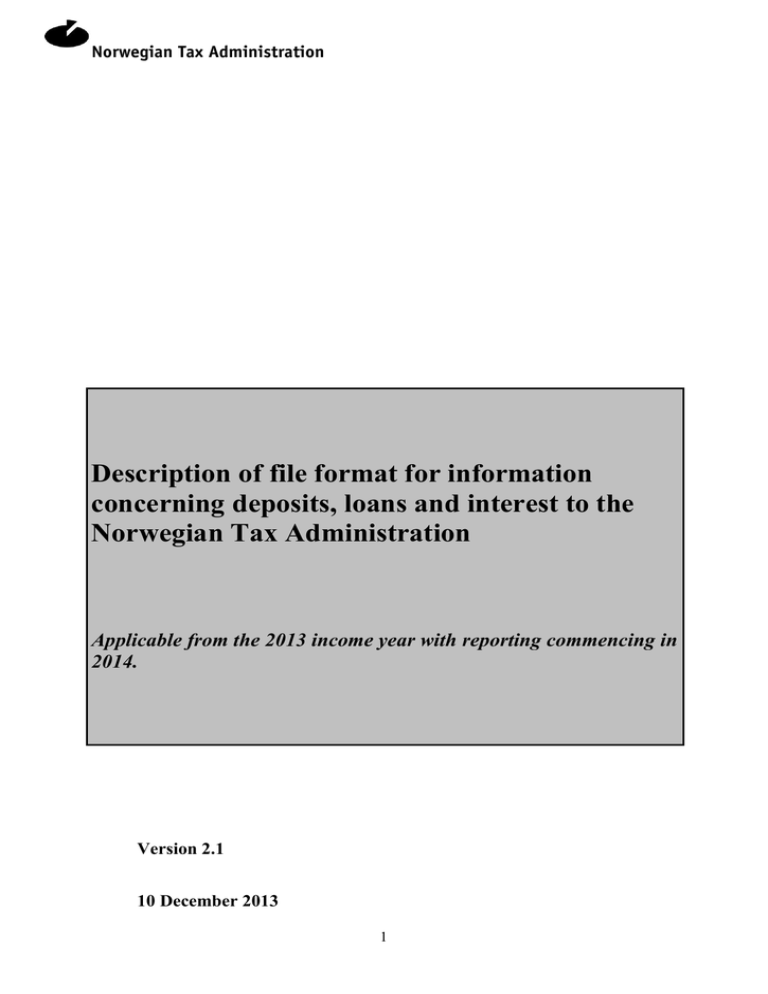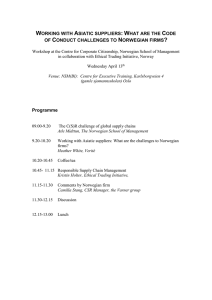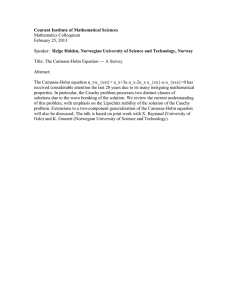Description of file format for information concerning
advertisement

Norwegian Tax Administration Description of file format for information concerning deposits, loans and interest to the Norwegian Tax Administration Applicable from the 2013 income year with reporting commencing in 2014. Version 2.1 10 December 2013 1 Norwegian Tax Administration Contents 1 2 Introduction ........................................................................................................................ 3 1.1 Glossary ....................................................................................................................... 3 1.2 Principal changes to the file format ............................................................................. 4 1.3 Marking of changes in the file format ......................................................................... 5 Structure and format of the XML document ...................................................................... 5 2.1 XML Schema Definition ............................................................................................. 5 2.2 UTF-8 character set ..................................................................................................... 5 2.3 Namespace ................................................................................................................... 5 2.4 XML Document structure ............................................................................................ 6 2.5 Unique identification of statement .............................................................................. 6 2.6 Correction of statements .............................................................................................. 7 2.7 XML element descriptions .......................................................................................... 7 2.8 Example files ............................................................................................................. 15 2 Norwegian Tax Administration Summary of changes Version 2.1 Date Description of change 16 August 2013 This document supersedes "Feltbeskrivelser Saldo-Rente" (Field descriptions Balance-Interest) The main format changes are described in section 1.2 Carried out by The SITS/MAG project 1 Introduction This document describes the requirements applicable to file attachments submitted in connection with the reporting of tax assessment statements for deposits, loans and interest via Altinn forms. It is assumed that attachment files meet the specifications for such files laid down by the Norwegian Tax Administration here. This document briefly describes the content of each element in the XML document. You will find a more detailed functional description of the expected content of the various fields in the tax assessment statements on the Norwegian Tax Administration's website: skatteetaten.no/likningsoppgaver. The target group for this document consists of anyone who is required to submit statements or tax assessment statements. 1.1 Glossary Some key words and terms used in this document are described below: Term Explanation UML (Unified Modelling Language) Unified Modelling Language (UML) is an industry standard for data-related modelling, administered by an international consortium called the Object Management Group (OMG). UTF-8 UTF-8 is a standard which defines a unicode character set with variable character length. The standard covers the Norwegian letters, as well as the characters in many other languages. The first 128 characters of UTF-8 are backwards-compatible with the US-ASCII standard. XML (Extensible Markup Language) XML is a universal extensible markup language. XML is a tool for sharing structured data between information systems, particularly via the internet. The XML file format organises data into a hierarchical structure. The format is an ordinary text format, readable by humans, where marks ("tags") give information on the content. 3 Norwegian Tax Administration Term Explanation XSD (XML Schema Definition) An XML format used to define the structure and legal content of an XML document. An XML Schema document can be used to validate a given XML document with regard to structure and content formats. 1.2 Principal changes to the file format The table below describes the changes made to the file format for the 2013 income year. 1.2.1 No changes for ordinary statements No changes are necessary for ordinary statements. A number of minor changes have been made to the file format, but the format and structure for ordinary statements approved in connection with reporting for 2012 remain valid. 1.2.2 Changes concerning replacements/corrections The functionality for the replacement/deletion of statements has changed: The submission types "erstatningsleveranse" and "erstatningsoppgaver" have been deleted and are no longer valid values. The element <erstatterReferanse> has been deleted, as this field was linked to submissions of the "erstatningsleveranse" type. Statements can be replaced by sending an ordinary submission with <oppgave> (same unique identification as the previously submitted statement). Statements can be deleted by sending an ordinary submission with <sletteoppgave> (same unique identification as the previously submitted statement). 1.2.3 Expansions of the message format (optional) The message format has been expanded with fields for: Source system International Taxpayer Identification Number New element - <kildesystem> For end user systems/specialist systems, information concerning the generating system should where possible be added to the element <kildesystem>. New element - <internasjonalIdentfikator> Optional fields have been added to indicate the TIN (Taxpayer Identification Number) of the account holder and/or user where applicable. TIN is an international term that is widely used in the exchange of tax data between the tax authorities in the OECD countries. The field is relevant to foreign individuals/enterprises which do not have a Norwegian national ID number/organisation number. 4 Norwegian Tax Administration 1.2.4 Specification of format controls Based on the experience that has been gained of reporting for 2012, a number of minor changes/specifications have been implemented in the format rules: Surname of personal account holder must be specified with a value The format control of contact information (telephone number and e-mail address) has been simplified Max. length of name set to 100 characters 1.2.5 Requirements concerning file attachments The zipping of XML files into a ZIP file prior to uploading as a file attachment is no longer required, and unzipped file attachments (xml) are now permissible provided the attachment does not exceed the maximum size for file attachments (200 Mb) 1.2.6 No statements to submit A new type of submission ("ingenoppgaver") for statement submitters who are subject to a reporting duty but do not have any tax assessment statements for the income year concerned 1.3 Marking of changes in the file format Changes in the format are indicated by a yellow background colour in the document. 2 Structure and format of the XML document 2.1 XML Schema Definition The format of the XML document that must be submitted is defined in XML Schema Definition (XSD). For the statement type "Innskudd, utlån og rente", the attachment "saldorente_<versjon>.xsd" contains this definition. It is assumed that the XML files that are submitted validate against this XSD document. 2.2 UTF-8 character set The UTF-8 character set must be used in the encoding of the XML document. To indicate that UTF-8 has been used as a character set, the following must be placed at the start of the XML file: <?xml version="1.0" encoding="UTF-8"?> 2.3 Namespace The element <melding> and all underlying types are defined in the namespace: xmlns="urn:ske:fastsetting:innsamling:saldoRente:2.0" 5 Norwegian Tax Administration Reference to this namespace, as well as reference to the standard namespace for XML instances, is made as attributes on the first element in the <melding> submission: <melding xmlns="urn:ske:fastsetting:innsamling:saldoRente:2.0" xmlns:xsi="http://www.w3.org/2001/XMLSchema-instance"> 2.4 XML Document structure The diagram below is a UML representation of the XML schema and shows the structure of the XML document. Figure 1 – Document structure (UML) 2.4.1 Amount fields All the amount items must be specified in whole NOK. The amount must be rounded to the nearest whole NOK (normal rounding rules). If an amount item is less than 50 øre, NOK 0 should be specified. 2.5 Unique identification of statement A submitted statement is uniquely identified by the statement submitter, the income year and account as described below: Statement submitter A statement submitter is identified through a Norwegian business enterprise number(organisation number) Account Account is identified by account number 6 Norwegian Tax Administration 2.6 Correction of statements In connection with the correction or deletion of a previously submitted statement, the requirement is that the new statement must have the same unique identifier as the original statement. This is because the Norwegian Tax Administration's systems must realise that this is a correction and not a new statement. See section 2.5 for a description of unique identifiers for statements 2.6.1 Correcting a statement A previously submitted statement can be corrected by submitting a new statement (<oppgave>) with the correct values. The new statement will then replace the previously submitted statement. If there is an error in one or more of the indicator fields in a previously submitted statement, this statement must be explicitly deleted (<sletteoppgave>). This means that a statement with the correct values and a deletion statement must then be submitted in order to delete the statement that was incorrect. 2.6.2 Deleting a statement Previously submitted statements can be deleted by submitting a deletion statement (<sletteoppgave>) with the same unique identifier as the statement that is to be deleted. 2.7 XML element descriptions The table below describes the various elements (fields) to be included in the XML document. The first column in the table indicates the type (complexType) in which the element is defined. Type Element Element description <melding> The submission's starting point of the type "Melding". The element <melding> is the root element in the XML document. Melding (Notification) <leveranse> A collection of statements from a single statement submitter, which are submitted at the same time. A "melding" must consist of at least one submission of the "Leveranse" type. Leveranse (Submission) <kildesystem> Specification of end user system and/or data system used for generating the submission/file attachment. The element is optional. Max. 100 characters. 7 Norwegian Tax Administration Type Element Element description <oppgavegiver> Statement submitters are banks, insurance companies, etc. which have money for management or which carry out lending activity. The submission's statement submitter is defined in the type Oppgavegiver. <inntektsaar> The year that the statement/tax assessment concerns. The income year is specified using four digits. <oppgavegiversLeverans ereferanse> A unique reference to a submission from a given statement submitter. The statement submitter's submission reference must be unique for a given statement submitter, income year and statement type. This reference will be shown in the acknowledgement from the Norwegian Tax Administration and can be used as a reference in connection with enquiries. The element is optional. Max. 100 characters. <leveransetype> Indicates whether the submission has new/amended statements (ordinaer) or whether a statement submitter has no statements to report (ingenoppgaver). Legal values: ordinaer ingenoppgaver <presentasjonsnavn> Presentation name of the tax return. Used only by agreement with the Norwegian Tax Administration. <oppgave> Set of statements of the Konto type. If the submission type is "ingenoppgaver", zero statements will be accepted. Otherwise, the submission must contain at least one statement. <sletteoppgave> Use a delete statement to delete a previously submitted statement. See the definition of the type SletteoppgaveKonto for the keys which must be specified for the deletion of a statement. <oppsummering> Check-sums calculated at submission level for the statements in the submission. See the definition of the type KontoOppsummering. Oppgavegiver (Statement submitter) <organisasjonsnummer> The 9-digit organisation number (Norwegian business enterprise number) of the statement submitter. 8 Norwegian Tax Administration Type Element Element description <organisasjonsnavn> Business enterprise name of the statement submitter. Max. 100 characters. <kontaktinformasjon> General contact information for the Norwegian Tax Administration linked to the submission of this statement type. Notification of message in Altinn will also use this information for mediation. Must be completed if a submitter is submitting on behalf of a number of statement submitters, i.e. several submissions are being submitted. For those who are only submitting on behalf of themselves (i.e. submitter = statement submitter), this information will be submitted in the Altinn submission form and may be excluded from the file. See the type Kontaktinformasjon for the elements that can be specified. Kontaktinformasjon (Contact information) <navn> Name of the statement submitter's contact person for the submission. Max. 100 characters. <telefonnummer> Telephone number on which the statement submitter's contact person can be reached. Max. 20 characters. <varselEpostadresse> E-mail address of the statement submitter to which notification of a message in Altinn (acknowledgements/error messages) may be sent. The e-mail address is specified in the format "ola.nordmann@bedrift.no" (the quotation marks must not be included). Max. 254 characters. <varselSmsMobiltelefon nummer> Telephone number of the statement submitter to which notification (SMS) of a message in Altinn (acknowledgements/error messages) may be sent. Must consist of numbers only. +XX is also accepted in front of foreign numbers, where XX is the country code. Max. 20 characters. Konto (Account) 9 Norwegian Tax Administration Type Element Element description <kontonummer> Unique identifying field for an account within a statement submitter. If the account has a number in accordance with the Norwegian standard (11 digits), this must be used. In the case of credit card accounts without another account number, the credit card number can be used (16 digits). Otherwise, a different unique identifying number must be used/constructed for the account. This could be an agreement number, accounting number, employee number or similar. It is also recommended that account numbers which concern anything other than bank accounts consist of digits only It is important that exactly the same account number is used in connection with the correction of previously submitted statements. If this is not the case, the correction will be in addition to the previously submitted statement If the person has a number of loans, these loans must be either merged or reported under different account numbers. Identical account numbers in the same submission will not be accepted. In the case of accounts marked with a "skattekontoegnethet" greater than 0, the account number must consist of 11 digits. <utlaan> Balance of the account (in whole Norwegian kroner) at the year-end if the account concerns a loan. The amount must be a positive number. <innskudd> Balance of the account (in whole Norwegian kroner) at the year-end if the account concerns a deposit. The amount must be a positive number. <skattekontoEgnethet> Tax settlement account coding. Relevant to banks only. Prioritisation of whether the account is suitable for paying excess tax to. Can have the value 0, 1, 2 or 3, or be empty. 10 Norwegian Tax Administration Type Element Element description <renter> Interest information http://www.skatteetaten.no/no/Altom/Likningsoppgaver/Rettledninger/saldo-og-renter/ Cf. Stipulation of the interest amount Cf. Defaulted loans See the type Renter for the fields that can be specified. <kontoeier> Information on the account holder. Account holder is either of the PersonligKontoeier (personal account holder) type or the VirksomhetsKontoeier (business account holder) type. All account holders have an address. What must be specified by other information will be determined by whether they are entities/enterprises or private individuals. See the type Kontoeier for the fields that must be specified. <disponent> Used if any "disponent" (user/signee) is an enterprise. See the type Disponent for the fields that are to be specified. SletteoppgaveKonto (Delete statement Account) <kontonummer> Unique identifying field for an account within a statement submitter. Renter (Interest) <opptjenteRenter> Interest on deposits. The amount must be a positive number in whole Norwegian kroner. <paaloepteRenter> Interest on loans. The amount must be a positive number in whole Norwegian kroner. <betalteMisligholdteRent er> Paid defaulted interest. The amount must be a positive number in whole Norwegian kroner. <tilbakebetalteMislighol dteRenter> The amount must be a positive number in whole Norwegian kroner and consist of reversed defaulted interest which is referred to in the guidance. Kontoeier (Account holder) 11 Norwegian Tax Administration Type Element Element description <kontoeier xsi:type=""> Account holder is an abstract type and the type of account holder that the statement concerns must be specified: ... </kontoeier> xsi:type="PersonligKontoeier" (personal account holder) xsi:type="Virksomhetskontoeier" (business account holder) Common elements for account holder (both types) <sektorkode> The sector code for the account holder; cf. Statistics Norway's (SSB) standard. SSB introduced new four-/five-digit sector codes from the 2012 income year. Banks are asked to report accounts using the correct sector code as either four or five digits. Other statement submitters must not report the sector code. The sector code helps the Norwegian Tax Administration to decide which account holders there is no absolute identification requirement for through Norwegian national identity number. In the long term, the correct use of sector codes will result in less feedback to the bank concerning lack of identification. <adresse> Residential address/business address for account holder. See the type GenerellAdresse for the fields that are to be specified. Additional elements for <kontoeier xsi:type="personligKontoeier"> <foedselsnummer> Personal identity number. The account holder's Norwegian national ID no. or D no. 11 digits. If the person does not have a Norwegian national ID no./D no., the date of birth can be reported in the format ddmmyy00000. <internasjonalIdentfikato r> TIN (Taxpayer Identification Number) is an international term that is widely used in the exchange of tax data between the tax authorities in the OECD countries. The field is relevant to foreign individuals/enterprises which do not have a Norwegian national ID number/organisational number. See the type InternasjonalIdentifikator for the fields that are to be specified. 12 Norwegian Tax Administration Type Element Element description <fornavn> First name of account holder. Text string of max. 100 characters. <mellomnavn> If the account holder's middle name is explicitly available, it must be entered here. In the event of doubt, it can be placed after the surname. Text string of max. 100 characters. <etternavn> Surname of account holder. If the statement submitter has saved the name in such a way that it is difficult to split into a first name and surname, the full name may be entered under surname. Must contain a value - text string of max. 100 characters. Additional elements for <kontoeier xsi:type="virksomhetsontoeier"> <organisasjonsnummer> Norwegian business enterprise number. Field for the account holder's organisation number. 9 digits. If the account holder is a foreign account holder without a Norwegian organisation number, nine zeroes (000000000) must be entered in this field. <internasjonalIdentfikato r> TIN (Taxpayer Identification Number) is an international term that is widely used in the exchange of tax data between the tax authorities in the OECD countries. The field is relevant to foreign individuals/enterprises which do not have a Norwegian national ID number/organisational number. See the type InternasjonalIdentifikator for the fields that are to be specified. <organisasjonsnavn> Business enterprise name. Text string of max. 100 characters. InternasjonalIdentfikator (International identification number) <identifikator> Identification number <identifikatortype> Type of identifier. Here, the value is "TIN" (Taxpayer Identification Number), which is currently the only legal value. <utstedtAvLand> Country code for the country that issued the identification number. Country codes are reported using the ISO-3166alpha-2 standard (two characters). GenerellAdresse (General address) <adressetekst> Address of the account holder (not including postal town information). 13 Norwegian Tax Administration Type Element Element description <postnummer> Postal number of the account holder. (No restriction on length), both Norwegian and foreign postal numbers may be entered here. <poststedsnavn> Postal town of the account holder. If it is not possible to distinguish between the postal number and the postal town (e.g. in the case of foreign addresses), the postal number + postal town can be entered here. <landkode> The country code for the account holder's address. The country code can now only be reported using the ISO-3166-alpha-2 standard (two characters). Disponent (User) <disponent xsi:type=""> ... </disponent> "Disponent" (user/segnee) is an abstract type and the type of user that the statement concerns must be specified: xsi:type="PersonligDisponent" (Account user/signee that is a person) xsi:type="Virksomhetsdisponent" (Account user/signee that is a business enterprise) Elements for <disponent xsi:type="PersonligDisponent" <foedselsnummer> Norwegian national ID no. or D no. 11 digits. If the person does not have a Norwegian national ID no./D no., the date of birth can be reported in the format: ddmmyy00000 <internasjonalIdentfikato r> See the description under "Account holder". <fornavn> The first name of the personal user. Text string of max. 100 characters. <mellomnavn> The middle name of the personal user. Text string of max. 100 characters. <etternavn> The surname of the personal user. Text string of max. 100 characters. Elements for <disponent xsi:type="Virksomhetsdisponent" <organisasjonsnummer> Norwegian business enterprise number. Field for organisation number for any user. 9 digits. <internasjonalIdentfikato r> See the description under "Account holder". 14 Norwegian Tax Administration Type Element Element description <organisasjonsnavn> Business enterprise name. Text string of max. 100 characters. KontoOppsummering (Account Summary) <antallOppgaver> Indicates the number of statements in the submission. <sumInnskudd> Sum of all deposit amounts in the statements belonging to a submission. The amount must be specified in whole Norwegian kroner. <sumUtlaan> Sum of all loan amounts in the statements belonging to a submission. The amount must be specified in whole Norwegian kroner. <sumOpptjenteRenter> Sum of all interest on deposits amounts in the statements belonging to a submission. The amount must be specified in whole Norwegian kroner. <sumPaaloepteRenter> Sum of all interest on loans amounts in the statements belonging to a submission. The amount must be specified in whole Norwegian kroner. <sumBetalteMisligholdte Renter> Sum of all paid defaulted interest amounts in the statements belonging to a submission. The amount must be specified in whole Norwegian kroner. <sumTilbakebetalteMisli gholdteRenter> Sum of all reversed defaulted interest amounts in the statements belonging to a submission. The amount must be specified in whole Norwegian kroner. 2.8 Example files Attached are some example files to help you understand the format and content of the reports. Purpose File name Description Normal submission saldorente_v2_eksempel_normal.xml XML file showing an example of a normal submission of new statements. 15 Norwegian Tax Administration Purpose File name Description Correction of statement Saldorente_v2_eksempel_korreksjon.xml XML file showing an example of a submission where the statement submitter corrects a selection of previously submitted individual statements. Deletion of statement saldorente_v2_eksempel_slett.xml XML file showing an example of a submission where the statement submitter deletes a previously submitted individual statement. No statements saldorente_v2_eksempel_ingen.xml An example which shows how a statement submitter can fulfil the reporting obligation without having any statements to report. 16



